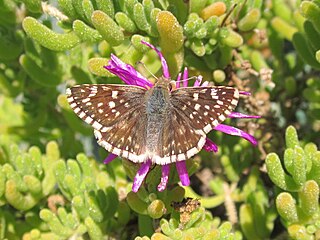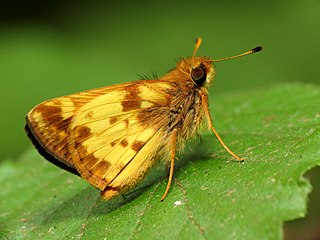
Skippers are a group of butterflies placed in the family Hesperiidae within the order Lepidoptera. They were previously placed in a separate superfamily, Hesperioidea; however, the most recent taxonomy places the family in the superfamily Papilionoidea, the butterflies. They are named for their quick, darting flight habits. Most have their antenna tips modified into narrow, hook-like projections. Moreover, skippers mostly have an absence of wing-coupling structure available in most moths. More than 3500 species of skippers are recognized, and they occur worldwide, but with the greatest diversity in the Neotropical regions of Central and South America.

Grass skippers or banded skippers are butterflies of the subfamily Hesperiinae, part of the skipper family, Hesperiidae. The subfamily was established by Pierre André Latreille in 1809.

Firetips or firetail skippers are skipper butterflies in the subfamily Pyrrhopyginae. The roughly 150 species are found only in the Neotropics, with the exception of one species which just reaches into the United States. Their common names refer to the red tuft at the end of the abdomen of many Pyrrhopyginae.

The Celaenorrhinini are a tribe of spread-winged skippers in the skipper butterfly subfamily Tagiadinae.

The giant skippers (Megathymini) are a tribe of butterflies in the family Hesperiidae.

Bungalotis is a genus of Neotropical butterflies in the family Hesperiidae (Eudaminae), in which they are placed to genus Phocidini.

Chamunda chamunda is a species of spread-winged skipper in the family Hesperiidae. It is the only species in the monotypic genus Chamunda and the monotypic subfamily Chamundinae. It is found from Assam to Burma, Thailand, Laos, Peninsular Malaysia and possibly Java.

Dyscophellus is a genus of largely Neotropical butterflies in the family Hesperiidae. The genus has been the subject of recent revisions based on genome analysis. It is currently placed in tribe Phocidini within the subfamily Eudaminae.
Eracon is a genus of skipper butterflies in the family Hesperiidae.

Lerodea is a genus of skippers in the family Hesperiidae.
Nerula is a genus of dicot skippers in the butterfly family Hesperiidae (Eudaminae).
Phareas is a genus of skippers in the family Hesperiidae, within which it is placed in tribe Phocidini.
Telegonus is a genus of skippers in the family Hesperiidae, in which it is placed in subtribe Eudamina. It has been the subject of recent revision, and now includes several species formerly in Astraptes, Autochton and Urbanus.

The Carcharodini are a tribe in the skipper butterfly subfamily Pyrginae. They are a very diverse but quite plesiomorphic and inconspicuous group distributed throughout the tropics.

The Erionotini are a tribe of skipper butterflies in the subfamily Hesperiinae.

Euriphellus is a genus of Neotropical butterflies in the family Hesperiidae, in which it is placed in the tribe Phocidini. The genus was separated from Dyscophellus by George Traut Austin in 2008, and originally contained a single species, Euriphellus euribates. Since then, several other species have been transferred to the genus.

Nicephellus is a monotypic genus of Neotropical butterflies in the family Hesperiidae, in which it is placed in tribe Phocidini.

Burnsius is a genus of New World checkered-skippers in the butterfly family Hesperiidae. The genus was erected by Nick V. Grishin in 2019.

Chirgus is a genus of checkered-skippers, white-skippers, and allies in the butterfly family Hesperiidae, found in the New World. The genus was erected by Nick V. Grishin in 2019. There are about six described species in Chirgus.

Lon is a genus of skipper butterflies found in North and South America. The genus was erected in 2019 by Nick V. Grishin. The name derives from the last syllable of the type species name.















